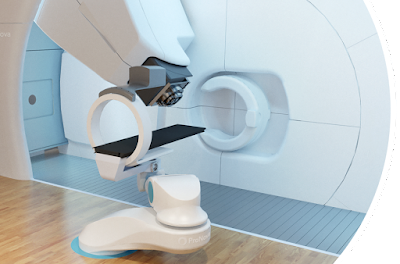While there are different ways to apply radiation, in external beam therapy, patients are literally placed at the cross hairs of particle accelerator to slam high energy particles into their bodies. I'd say "into the tumor", but if the surgery was successful, there's no tumor left. The particle beam is slamming into tissue to wipe out a few bad cells that may have slipped past the scalpel into the body, and not been poisoned by the chemotherapy.
(XKCD 933)
Last week, Design News wrote about an innovation in creating these "flesh-searing relativistic particle cannons" from MIT.
For many different types of cancers among patients in various age groups, proton beam radiotherapy treatment (PBRT) is a desirable alternative to other types of radiation therapy. In PBRT, synchrocyclotrons, cyclotrons, isochronous cyclotrons, synchrotrons, and other proton accelerators release high-energy proton beams to radiate cancerous tumors. A proton beam can be directly aimed at a tumor, sparing healthy surrounding tissue from radiation.The article claims many improvements for the new PBRT machines over the old design, including a cleaner, more patient friendly layout. ProNova Solutions is the company commercializing this treatment. High temperatures superconductors have been around since the late 80s, but don't have much role in the world outside the physics lab. I'm aware of some superconducting electronics sold for use in cellular base stations (paper here - pdf warning) and that puzzled me. The infrastructure to pump liquid nitrogen over these systems must be a big cost, but it was explained that the rent paid for cellular installations on buildings like the Sears Tower or Empire State goes into the millions of dollars per square foot.
With only 14 clinics in the U.S., PBRT is not available to all who qualify. For more than 10 years, scientists at MIT’s Plasma Science and Fusion Center (PSFC) have been researching new synchrocyclotron designs to lower PBRT-machine costs in cancer-treating clinics around the world.
In 2008, a team at MIT’s Plasma Science and Fusion Center designed a lightweight and compact synchrocyclotron by replacing the copper electromagnetic coils with superconducting varieties. Superconductive coils are cooled to low temperatures in order to reduce the resistivity of the material. They allow for smaller coils with less turns to generate higher magnetic fields, and can decrease the overall weight of an accelerator.
The new design could be placed directly on the gantry head that directs the proton beam at tumors. MIT’s synchrocyclotron gantry design replaces the old setup—the synchrocyclotron’s large size typically requires a separate room from the gantry and patient.
(Source)
It's a cool design and interesting to see superconductor technology in medicine... but it's still to create a machine to shoot you with high energy particles out of a "flesh-searing relativistic particle cannons". It's still a pretty awful thing to do to a person. I keep hearing that genomics is going to radically change cancer therapy. Obsoleting this sort of treatment would be wonderful.


There are various kinds of cancer and where they appear in the body changes the end results. However, there are two types of cancer; that is there are agressive cancers that metastisize easily and less aggressive cancers that tend to stay put. If you have the latter then you can usualy expect tosurvive usingone of the three treatments. If you have the former they cannot "cure" you and the cancer will kill you. That is true today, it was true 20-50years ago and I see nothing on the horizon to change it in spite of the cheery reports we get from time to time. I think the reason we keep getting these optimistic reports is to encourage funding for these studies. Simple as that.
ReplyDeleteFrom what I read, and I'm no doctor, that's essentially right. Basically, there are some cancers that have had progress made against them, but the biggest advance has been earlier detection. There seems to be some number of cancer cells that seems to be a limit beyond which the body is overwhelmed. The sooner it's found, the smaller the tumor and smaller the number of cells, so early detection accounts for most of the progress they claim.
ReplyDeleteI agree that early detection is good and in some cases may make the difference between life and death. But the stats are exagarated. Let me give you an exampleof why/how that happens:
ReplyDeleteMy father in law and mother in law both died from lung cancer which matasticized to their brains. My father in law was diagnosed early and received treatments and lived about 5 years after diagnoses. My mother in law was diagnosed late and her fear of the disease made her hesitate to get effective treatment and died about 18 months after diagnoses. Seems to support early detection, right? But in fact they were both just about as far along when they died. That is my father in law lived five years (that is 3 1/2 years longer than his wife) but essentially he was diagnosed about 3 1/2 years earlier than his wife even though their disease was equivalent. So he didn't live any longer he was merely diagnosed earlier and that is when the clock started ticking. I don't fault my mother in law for at first choosing to not undergo chemo or radiation her life after diagnoses was for the most part fine with the exception that she knew she was dying. My father in law underwent chemo, radiation and much later something called the gamma knife and his life was for the most part fine except that he knew he was dying.
So does early diagnoses of a aggressive cancer that is prone to matasticize? Probably not but it seems like it does because you "know" about it longer.